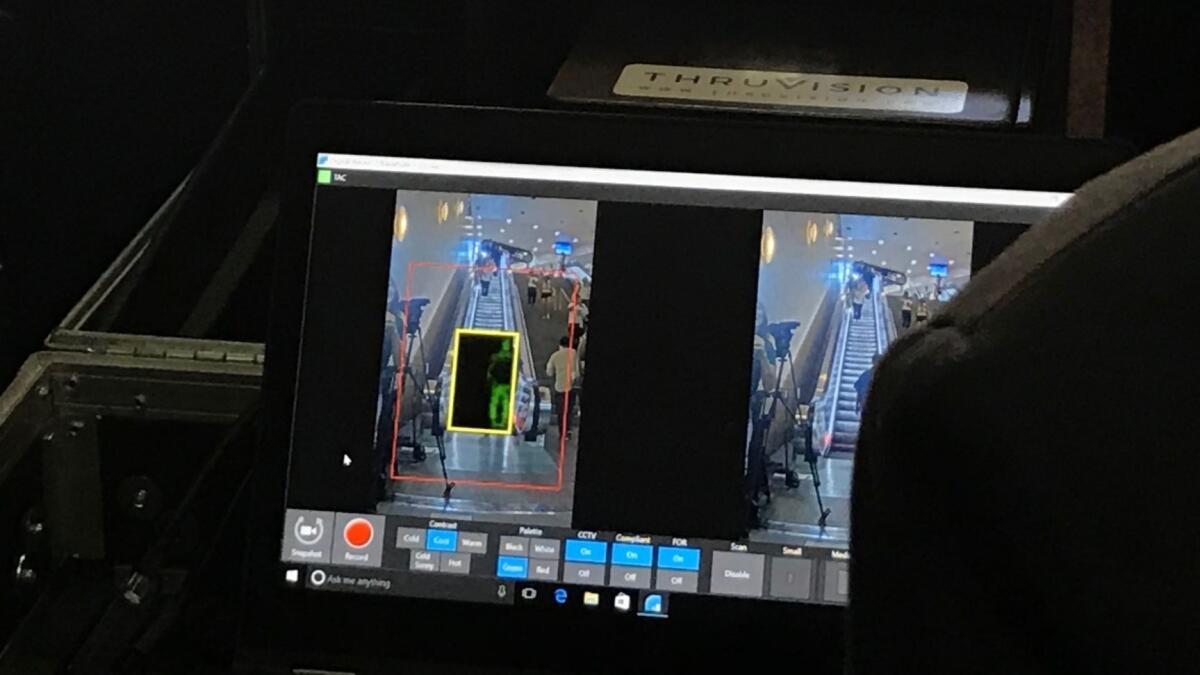L.A.’s rail system will be first in the U.S. to use scanners that detect explosives

- Share via
Los Angeles County’s rail system will be the first in the United States to deploy body scanners that can detect suicide vests and other improvised explosives, transportation officials said Tuesday.
Later this year, the Metropolitan Transportation Authority will deploy several portable scanners that can be moved to any of the system’s 93 subway and light-rail stations. The devices will be used in response to terrorism threats, or to scan large crowds at a station near a protest or a sporting event, officials said.
The scanners resemble a small trunk on wheels. They can be pointed toward an escalator or a station entrance, and can scan people from 30 feet away without requiring people to line up or slow down.
“We will be looking at areas where we can screen large numbers of passengers with minimal inconvenience,” Metro security chief Alex Wiggins said at Union Station on Tuesday.
Despite fears that transit systems could be attacked, body scanners and metal detectors are rare on U.S. rail systems, in part because the technology does not work fast enough to process a significant share of commuters at rush hour.
Metro’s new scanners cost about $100,000 each and can process more than 2,000 people an hour, Metro spokesman Dave Sotero said — an improvement over previous generations of scanners but a fraction of the crowds at the system’s busiest stations.
The device, made by Thruvision, is one of several devices approved by the Transportation Security Administration that Metro has tested over the last year. The agency is considering buying other models as well, Sotero said.
The scanners use radio waves to identify objects, including guns and nonmetallic explosives, concealed under a jacket or in a pocket.
The scanner uses a split-screen display, showing a video feed of each person as he or she approaches and a green outline of the body. The software displays a black square in any area where someone could be concealing a weapon or explosive.

The devices are designed to detect weapons — including bombs and assault-style rifles — that could be used for “mass casualty” attacks, Wiggins said. He declined to comment on whether someone carrying a handgun would be stopped and searched.
The scanner can be run by one person, but Metro will keep other officers nearby to handle bomb-sniffing dogs and to perform further searches, Wiggins said.
Wiggins declined to comment on exactly how the agency will respond to images that show a possible weapon. He also declined to comment on where the scanners will be used but said they will be “randomized.”
Riders will be warned that they will be subject to search before they are scanned, Wiggins said. (At Union Station on Tuesday, a sign posted next to the body scanner read, “Passengers proceeding past this point are subject to Metro security screening and inspection.”)
“One thing we have to be sensitive to is the 4th Amendment, unreasonable search and seizure,” Wiggins said. “We will make it very, very clear that individuals are entering an area where they’re subject to search.”
Riders who “want to opt out, can opt out,” Wiggins said, but could be barred from entering the station if they refuse to be screened. He added: “That means not taking transit that day.”
For more transportation news, follow @laura_nelson on Twitter.
More to Read
Sign up for Essential California
The most important California stories and recommendations in your inbox every morning.
You may occasionally receive promotional content from the Los Angeles Times.











